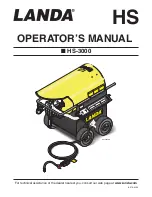
94
EN
REMOVAL / INSPECTION /
AINTENANCE / REPLACEMENT
OF THE SPARK PLUG
For the problem-free starting and operation of the
engine, the electrodes of the spark plug must not be
clogged, the spark plug must be correctly set and
installed.
•
WARNING
y
The engine and the exhaust pipe are very hot while the
pressure washer is running and for a long time after it
has been turned off. Allow the pressure washer to cool
down before checking it.
1. Remove the spark plug cover (fig. 13) and remove
the spark plug using an appropriate spark plug key
(fig. 14).
2. Visually inspect the exterior appearance of the
spark plug.
y
If the spark plug has clogged electrodes, file them
down on all sides using sandpaper (fig. 15).
y
Using a gauge, check that the distance between the
electrodes is 0.6-0.8 mm and that the gasket ring is
in order (fig. 16).
y
If the spark plug is visibly significantly clogged or if
the insulator is cracked or it is peeling, replace the
spark plug with a new one (the spark plug type is
specified in the technical specifications).
3. Then screw the spark plug back in by hand.
4. Once the spark plug is seated, tighten it using
a spark plug key to compress the gasket ring.
Note:
y
After hand tightening the new spark plug, it is neces-
sary to turn it by approx. 1/2 a rotation to compress
the gasket ring. If this is a reused older spark plug, it is
only necessary to tighten it by 1/8 to 1/4 of a rotation.
A spark plug is a consumable good, and its wear
and tear is not covered by the warranty.
•
ATTENTION
y
Make sure that the spark plug is well tightened. An
incorrectly tightened spark plug clogs and heats
up significantly and could seriously damage to the
engine.
5. Place the spark plug connector back on to the
spark plug so that it clicks in place.
In the event that
the connector is not correctly attached, the engine
may not start up.
SPARK PLUG FUNCTION TEST
•
ATTENTION
y
First ensure that there is no spilled petrol or other
flammable substances in the vicinity. When testing
functionality, use suitable protective gloves. When wor-
king without gloves there is a risk of injury by electrical
shock! Before removing the spark plug, make sure that
the spark plug is not hot!
1. Screw the spark plug out of the engine as descri-
bed above.
2. Put the spark plug into the spark plug connector,
check that the spark plug is correctly seated in the
connector, otherwise it will not be conductively
connected.
3. Move the power switch to the "ON" position.
4. Hold the thread of the spark plug against the body
of the engine (e.g. on the cylinder head) and pull
on the handle of the pull starter.
5. If there is no sparking, replace the spark plug with
a new one. In the event that no sparking occurs
even with the new spark plug, it is necessary
arrange a repair at an authorised service centre.
If the sparking is in order, reinstall the spark plug
and continue starting the engine according to the
manual. If the sparking is in order and the engine
still refuses to start, try replacing the spark plug
for a new one.
MAINTENANCE OF THE PETROL
FILTRATION STRAINER IN THE
REFILL NECK OF THE FUEL TANK
•
ATTENTION
y
Never pour petrol into the fuel tank without the original
filtration strainer being inserted. The filtration strainer
protects the fuel system against potential mechanical
contaminants in the petrol, which could clog the fuel
system.
1. Screw open the fuel cap and remove the filtration
strainer inserted in the neck of the fuel tank (fig.
17). Rinse the strainer in any non-flammable cle-
aning agent (e.g. detergent solution), or it is also
possible to use a brush with soft plastic bristles
and then rinse the strainer under clean water and
allow it to dry thoroughly so that water does not
come into contact with petrol. In the event that the
strainer is excessively soiled, replace it with a new
original one.
2. Return the cleaned strainer back into the neck of
the fuel tank.
3. Put the fuel tank cap back on and tighten it firmly.
Содержание 8896351
Страница 99: ......






































